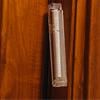The Jews of Novi Sad, Serbia, got an emotional infusion of Jewish inspiration on Sunday when two Chabad-Lubavitch "Roving Rabbis" presided over a ceremony to affix a mezuzah to the door of the town's synagogue. The last time the building had one was before World War II.
With tears flowing down the cheeks of Holocaust survivors, whose country suffered once more in a series of wars in the 1990s, a crowd of a few hundred Jews gathered in confirming that Judaism had not yet departed Novi Sad and is, on the contrary, strengthening.
It being the Hebrew month of Elul, the rabbinical students, who were dispatched to Serbia by Merkos L'Inyonei Chinuch, the Brooklyn, N.Y.-based educational arm of Chabad-Lubavitch, also took the opportunity to blow the synagogue's shofar for the town. As with the mezuzah, the last time the shofar had been blown was more than 60 years ago.
"The people in this community have never seen such an event before," said Dr. Ana Frankel, the devoted and energetic president of the Novi Sad Jewish community.
"These doors once saw joyous children before the war," said Rabbi Motti Seligson at the event. "The affixing of the mezuzah on the door here is a sign that the Jewish community will once again walk through these doors for more joyous events."
Emotions reached a crescendo when Seligson and his partner, Rabbi Saadya Notik, led the crowd in covering their eyes and praying the Shema, which proclaims the unity of G‑d and forms the scriptural passage written on the mezuzah's parchment.
Seligson, who came to Novi Sad as part of a Lubavitch summer program that sends pairs of students to far-flung locations across the globe to strengthen Jews wherever they may be found, found in the Serbian town 50 miles north of Belgrade a "young community that has a great thirst for Judaism."
It's also a community rich in history, bearing the traumas of the Holocaust and a spate of civil wars: Elza Farkas, an 84-year-old Holocaust survivor, reminded everyone of the community's past when she revealed her tattooed arm to the rabbis before Notik blew the shofar.
Before World War II, 4,500 Jews called Novi Sad home. In the infamous Novi Sad Raid of January 1942, just months after the Nazi invasion established a puppet government loyal to Germany, Hungarian police murdered more than 1,200 Jews over a period of three days. The Nazis rounded up the town's remaining Jews in 1944, sending most of them to Auschwitz. Few survived; fewer still returned.
But even after the period of wars in the 1990s, which set in motion a steady decrease in Novi Sad's Jewish population year after year, today, "Judaism is on the rise," said Frankel, who has led the community of an estimated 630 for three years. "We have a Jewish club here, we care for the elderly and we have lectures on Jewish topics."
A Shabbat to Remember

"It was very good," said Pavle Sosberger, 87, who lost his entire family during the war and reputedly is the oldest Jew living in Novi Sad. His grandfather donated the synagogue's stained-glass windows.
"We have no rabbi here, and the nice and enthusiastic Chabad boys made a very successful Shabbat," he said.
The services and dinner "were interesting," said his granddaughter, Dinah Sosberger. "They explained the prayers and people enjoyed it.
"A lot more than usual came, and there were a lot of young Jews," she continued. "Everyone left with positive feelings; they felt comfortable as Jews here. That is important."
Frankel pronounced the rabbis' efforts at educating the community a success, and expressed her wish that a more permanent rabbinical presence might yet be established in Novi Sad.
"What we need most is education," she said. "These two young rabbis gave fantastic lectures.
"We need someone like them," she added. "And the best thing is that Chabad will be sending two rabbis for the High Holidays to lead the prayers."








Start a Discussion